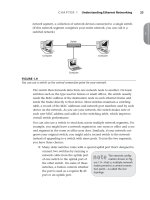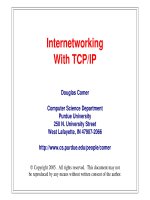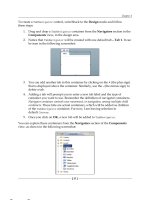Internetworking with TCP/IP- P2 pps
Bạn đang xem bản rút gọn của tài liệu. Xem và tải ngay bản đầy đủ của tài liệu tại đây (343.64 KB, 10 trang )
Contents
ix
Chapter
5
Mapping lnternet Addresses To Physical Addresses (ARP)
77
Introduction
77
The Address Resolution Problem
77
Two Types Of Physical Addresses
78
Resolution Through Direct Mapping
78
Resolution Through Dynamic Binding
79
The Address Resolution Cache
80
ARP Cache Timeout
8
1
ARP Refinements
82
Relationship
Of
ARP To Other Protocols
82
ARP Implementation
82
ARP Encapsulation And Identification
84
ARP Protocol Format
84
Summary
86
Chapter
6
Determining An Internet Address At Startup (RARP) 89
6.1
Introduction
89
6.2 Reverse Address Resolution Protocol
(RARP)
90
6.3 Timing
RARP
Transactions
92
6.4 Primary And Backup RARP Servers
92
6.5 Summary
93
Chapter
7
Internet Protocol: Connectionless Datagram Delivery 95
7.1
Introduction
95
7.2 A Virtual Network
95
7.3 Internet Architecture And Philosophy
96
7.4 The Conceptual Service Organization
96
7.5 Connectionless Delivery System
97
7.6 Purpose
Of
The Internet Protocol
97
7.7
The Internet Datagram
97
7.8 Internet Datagram Options
107
7.9 Summary
113
Chapter 8 internet Protocol: Routing IP Datagrams
8.1 Introduction
1
15
8.2 Routing In An Internet
115
8.3
Direct And Indirect Delivery
117
Contents
Table-Driven IP Routing
119
Next-Hop Routing
119
Default Routes
121
Host-Specific Routes
12 1
The IP Routing Algorithm
121
Routing With 1P Addresses
122
Handling Incoming Datagram
124
Establishing Routing Tables
125
Summary
125
Chapter
9
Internet Protocol: Error And Control Messages (ICMP)
129
Introduction
129
The Internet Control Message Protocol
129
Error Reporting vs. Error Correction
130
ICMP Message Delivery
13 1
lCMP Message Format
132
Testing Destination Reachability And Status (Ping)
133
Echo Request And Reply Message Format
134
Reports Of Unreachable Destinations
134
Congestion And Datagram Flow Control
136
Source Quench Format
136
Route Change Requests From Routers
137
Detecting Circular Or Excessively Long Routes
139
Reporting Other Problems
140
Clock Synchronization And Transit Time Estimation
140
Information Request And Reply Messages
142
Obtaining A Subnet Mask
142
Router Discovery
143
Router Solicitation
144
Summary
145
Chapter
10
Classless And Subnet Address Extensions (CIDR)
147
Introduction
147
Review Of Relevant Facts
147
Minimizing Network Numbers
148
Transparent Routers
149
Proxy ARP
150
Subnet Addressing
152
Flexibility In Subnet Address Assignment
154
Variable-Length Subnets
155
Contents
10.9 lmplementation Of Subnets With Masks
156
10.10 Subnet Mask Representation
157
10.1 1 Routing In The Presence Of Subnets
158
10.12 The Subnet Routing Algorithm
159
10.13 A Unified Routing Algorithm
160
10.14 Maintenance Of Subnet Masks
161
10.15 Broadcasting To Subnets
161
10.16 Anonymous Point-To-Point Networks
162
10.1 7 Classless Addressing (Supernetting)
164
10.18 The Effect Of Supernetting On Routing
165
10.19 ClDR Address Blocks And Bit Masks
165
10.20 Address Blocks And CIDR Notation
166
10.21 A Classless Addressing Example
167
10.22 Data Structures And Algorithms For Classless Lookup
167
10.23 Longest-Match Routing And Mixtures Of Route Types
170
10.24 CIDR Blocks Reserved For Private Networks
172
10.25 Summary
173
Chapter
11
Protocol Layering
11 .I Introduction
177
1
I
.2 The Need For Multiple Protocols
177
11.3 The Conceptual Layers Of Protocol So@are
178
11.4 Functionality Of The Layers
18
1
11.5 X.25 And Its Relation To The IS0 Model
182
11.6 Differences Between IS0 And Internet Layering
185
11.7 The Protocol Layering Principle
187
11.8 Layering In The Presence Of Network Substructure
189
11.9 Two Important Boundaries In The TCPIIP Model
19
1
11
.lo
The Disadvantage Of Layering
192
11 .I 1 The Basic Idea Behind Multiplexing And Demultiplexing
192
11.12 Summary
194
Chapter
12
User Datagram Protocol (UDP)
12.1 Introduction
197
12.2 IdentifLing The Ultimate Destination
197
12.3 The User Datagram Protocol
198
12.4 Format Of UDP Messages
199
12.5 UDP Pseudo-Header
200
12.6 UDP Encapsulation And Protocol Layering
201
12.7 Layering
And
The UDP Checksum Computation
203
xii
12.8 UDP Multiplexing, Demultiplexing, And Ports
203
12.9 Reserved And Available UDP Port Numbers
204
12.10 Summary
206
Chapter
13
Reliable Stream Transport Service
(TCP)
13.1 Introduction
209
13.2 The Need For Stream Delivery
209
13.3 Properties Of The Reliable Delivery Service
210
13.4 Providing Reliability
2 1 1
13.5 The Idea Behind Sliding Windows
21 3
13.6 The Transmission Control Protocol
2 15
13.7 Ports, Connections, And Endpoints
216
13.8 Passive And Active Opens
21 8
13.9 Segments, Streams, And Sequence Numbers
219
13.10 Variable Window Size And Flow Control
220
13.11 TCP Segment Format
221
13.12 Out Of Band Data
222
13.13 Maximum Segment Size Option
223
13.14 TCP Checksum Computation
224
13.15 Acknowledgements And Retransmission
225
13.16 Timeout And Retransmission
226
13.17 Accurate Measurement Of Round Trip Samples
228
13.18 Karn's Algorithm And Timer Backoff
229
13.19 Responding To High Variance In Delay
230
13.20 Response To Congestion
232
13.21 Congestion, Tail Drop, And TCP
234
13.22 Random Early Discard (RED)
235
13.23 Establishing A TCP Connection
237
13.24 Initial Sequence Numbers
239
13.25 Closing a TCP Connection
239
13.26 TCP Connection Reset
241
13.27 TCP State Machine
241
13.28 Forcing Data Delivery
243
13.29 Reserved TCP Port Numbers
243
13.30 TCP Performance
243
13.31 Silly Window Syndrome And Small Packets
245
13.32 Avoiding Silly Window Syndrome
246
13.33 Summary
249
Contents
Chapter
14
Routing: Cores, Peers, And Algorithms
14.1
Introduction
253
14.2
The Origin Of Routing Tables
254
14.3
Routing With Partial Information
255
14.4
Original Internet Architecture And Cores
256
14.5
Core Routers
257
14.6
Beyond The Core Architecture To Peer Backbones
260
14.7
Automatic Route Propagation
262
14.8
Distance Vector (Bellman-Ford) Routing
262
14.9
Gateway-To-Gateway Protocol (GGP)
264
14.10
Distance Factoring
265
14.11
Reliability And Routing Protocols
265
14.12
Link-State (SPF) Routing
266
14.13
Summury
267
Chapter
15
Routing: Exterior Gateway Protocols And Autonomous
269
Systems (BGP)
15.1
Introduction
269
15.2
Adding Complexity To The Architectural Model
269
15.3
Determining A Practical Limit On Group Size
270
15.4
A Fundamental Idea: Extra Hops
271
15.5
Hidden Networks
273
15.6
Autonomous System Concept
274
15.7
From A Core To Independent Autonomous Systems
275
15.8
An Exterior Gateway Protocol
276
15.9
BGP Characteristics
277
15.10
BGP Functionality And Message Types
278
15.11
BGP Message Header
278
15.12
BGP OPEN Message
279
15.13
BGP UPDATE Message
280
15.14
Compressed Mask-Address Pairs
28
1
15.15
BGP Path Attributes
282
15.16
BGP KEEPALNE Message
283
15.1 7
Information From The Receiver's Perspective
284
15.18
The Key Restriction Of Exterior Gateway Protocols
285
15.19
The Internet Routing Arbiter System
287
15.20
BGP NOTIFICATION Message
288
15.21
Decentralization Of Internet Architecture
289
15.22
Summary
290
xiv
Contents
Chapter
16
Routing: In An Autonomous System (RIP, OSPF, HELLO)
293
Introduction
293
Static Vs. Dynamic Interior Routes
293
Routing Information Protocol (RIP)
296
The Hello Protocol
305
Delay Metrics And Oscillation
305
Combining
RIP,
Hello, And BGP
307
Inter-Autonomous System Routing
307
Gated: Inter-Autonomous System Communication
308
The Open SPF Protocol (OSPF)
308
Routing With Partial Information
3 15
Summary
315
Chapter
17
Internet Multicasting
17.1 Introduction
3 19
17.2 Hardware Broadcast
3
19
17.3 Hardware Origins Of Multicast
320
17.4 Ethernet Multicast
32
1
17.5 IP Multicast
321
17.6 The Conceptual Pieces
322
17.7 IP Multicast Addresses
323
17.8 Multicast Address Semantics
325
17.9 Mapping IP Multicast To Ethernet Multicast
325
17.10 Hosts And Multicast Delivery
326
17.11 Multicast Scope
326
17.12 Extending Host Software To Handle Multicasting
327
17.13 Internet Group Management Protocol
328
17.14 IGMP Implementation
328
17.15 Group Membership State Transitions
329
17.16 IGMP Message Format
331
17.1 7 Multicast Forwarding And Routing Information
332
17.18 Basic Multicast Routing Paradigms
334
17.1 9 Consequences Of TRPF
335
17.20 Multicast Trees
337
17.21 The Essence Of Multicast Routing
338
17.22 Reverse Path Multicasting
338
17.23 Distance Vector Multicast Routing Protocol
339
17.24 The Mrouted Program
340
17.25 Alternative Protocols
343
17.26 Core Based Trees (CBT)
343
17.27 Protocol Independent Multicast (PIM)
344
Contents
17.28 Multicast Extensions To OSPF (MOSPF)
347
17.29 Reliable Multicast And ACK Implosions
347
17.30 Summary
349
Chapter
18
TCPnP Over ATM Networks
18.1 Introduction
353
18.2 ATM Hardware
354
18.3 Large ATM Networks
354
18.4 The Logical View Of An ATM Network
355
18.5 The Two ATM Connection Paradigms
356
18.6 Paths, Circuits, And Identifiers
357
18.7 ATM Cell Transport
358
18.8 ATM Adaptation Layers
358
18.9 ATM Adaptation Layer 5
360
18.10
AALS
Convergence, Segmentation, And Reassembly
361
18.11 Datagram Encapsulation And IP
MTU
Size
361
18.12 Packet Type And Multiplexing
362
18.13 IP Address Binding In An ATM Network
363
18.14 Logical IP Subnet Concept
364
18.15 Connection Management
365
18.16 Address Binding Within An WS
366
18.1 7 ATMARP Packet Format
366
18.18 Using ATMARP Packets To Determine An Address
369
18.19 Obtaining Entries For A Server Database
370
18.20 Timing Out ATMARP Information In A Server
370
18.21 Timing Out ATMARP Information In A Host Or Router
371
18.22
1P
Switching Technologies
371
18.23 Switch Operation
372
18.24 Optimized IP Forwarding
372
18.25 Classification, Flows, And Higher Layer Switching
373
18.26 Applicability Of Switching Technology
374
18.27 Summary
374
Chapter
19
Mobile lP
19.1 Introduction
377
19.2 Mobility, Routing, and Addressing
377
19.3 Mobile IP Characteristics
378
19.4 Overview Of Mobile IP Operation
378
19.5 Mobile Addressing Details
379
19.6 Foreign Agent Discovery
380
19.7 Agent Registration
38 1
19.8 Registration Message Format
38
1
19.9 Communication With A Foreign Agent
383
19.10 Datagram Transmission And Reception
383
19.11 The Two-Crossing Problem
384
19.12 Communication With Computers On the Home Network
385
19.13 Summary
386
Chapter 20 Private Network Interconnection (NAT, VPN)
20.1 Introduction
389
20.2 Private And Hybrid Networks
389
20.3 A Virtual Private Network (VPN)
390
20.4 VPN Addressing And Routing
392
20.5 A VPN With Private Addresses
393
20.6 Network Address Translation (NAT)
394
20.7 NAT Translation Table Creation
395
20.8 Multi-Address NAT
396
20.9 Port-Mapped NAT
396
20.10 Interaction Between NAT And ICMP
398
20.1 1 Interaction Between NAT And Applications
398
20.12 Conceptual Address Domains
399
20.13 Slirp And Masquerade
399
20.14 Summary
400
Chapter 21 Client-Server Model
Of
Interaction
Introduction
403
The Client-Server Model
403
A Simple Example: UDP Echo Server
404
Time And Date Service
406
The Complexity of Servers
407
RARP
Server
408
Alternatives To The Client-Server Model
409
Summary
410
Chapter
22
The Socket Interface
22.1 Introduction
41 3
22.2 The UNIX NO Paradigm And Network 110
414
22.3 Adding Network 110 to UNIX
414
Contents
xvii
22.4 The Socket Abstraction
41 5
22.5 Creating A Socket
415
22.6 Socket Inheritance And Termination
416
22.7 Specifying A Local Address
41 7
22.8 Connecting Sockets To Destination Addresses
4 18
22.9 Sending Data Through A Socket
419
22.1 0 Receiving Data Through A Socket
421
22.11 Obtaining Local And Remote Socket Addresses
422
22.12 Obtaining And Setting Socket Options
423
22.13 Specifying A Queue Length For A Server
424
22.14 How A Server Accepts Connections
424
22.15 Servers That Handle Multiple Services
425
22.16 Obtaining And Setting Host Names
426
22.1 7 Obtaining And Setting The Internal Host Domain
427
22.1 8 Socket Library Calls
427
22.19 Network Byte Order Conversion Routines
428
22.20
IP
Address Manipulation Routines
429
22.21 Accessing The Domain Name System
431
22.22 Obtaining Information About Hosts
432
22.23 Obtaining Information About Networks
433
22.24 Obtaining Information About Protocols
434
22.25 Obtaining Information About Network Services
434
22.26 An Example Client
435
22.27 An Example Server
437
22.28 Summary
440
Chapter
23
Bootstrap And Autoconfiguration (BOOTP, DHCP)
443
Introduction
443
The Need For An Alternative To
RARP
444
Using
IP
To Determine An
IP
Address
444
The BOOTP Retransmission Policy
445
The BOOTP Message Format
446
The Two-step Bootstrap Procedure
447
Vendor-Specific Field
448
The Need For Dynamic Configuration
448
Dynamic Host Configuration
450
Dynamic IP Address Assignment
450
Obtaining Multiple Addresses
45
1
Address Acquisition States
452
Early Lease Termination
452
Lease Renewal States
454
DHCP Message Format
455
xviii
Contents
23.16
DHCP Options And Message Type
456
23.1 7
Option Overload
457
23.18
DHCP And Domain Names
457
23.19
Summary
458
Chapter
24
The Domain Name System (DNS)
24.1
Introduction
461
24.2
Names For Machines
462
24.3
Flat Namespace
462
24.4
Hierarchical Names
463
24.5
Delegation Of Authority For Names
464
24.6
Subset Authority
464
24.7
Internet Domain Names
465
24.8
Oficial And Unoficial Internet Domain Names
466
24.9
Named Items And Syntax Of Names
468
24.10
Mapping Domain Names To Addresses
469
24.1 1
Domain Name Resolution
471
24.1 2
Eficient Translation
472
24.13
Caching: The Key To Eficiency
473
24.14
Domain Server Message Format
474
24.15
Compressed Name Format
477
24.16
Abbreviation Of Domain Names
477
24.1 7
Inverse Mappings
478
24.18
Pointer Queries
479
24.19
Object Types And Resource Record Contents
479
24.20
Obtaining Authority For
A
Subdomain
480
24.21
Summary
481
Chapter
25
Applications: Remote Login (TELNET, Rlogin)
Introduction
485
Remote Interactive Computing
485
TELNET Protocol
486
Accommodating Heterogeneity
488
Passing Commands That Control The Remote Side
490
Forcing The Server To Read A Control Function
492
TELNET Options
492
TELNET Option Negotiation
493
Rlogin (BSD UNlX)
494
Summary
495









